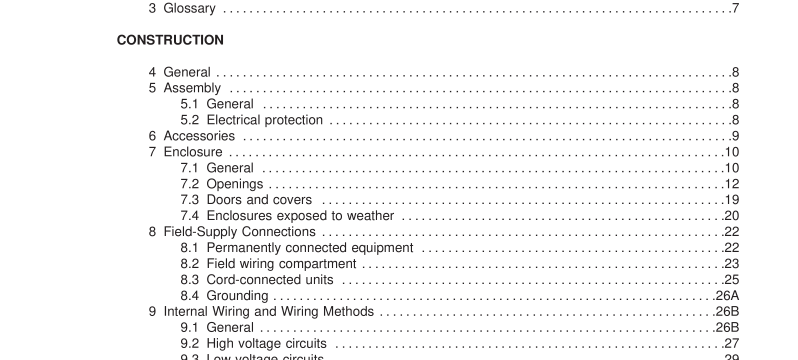UL 427-2008 pdf download.Refrigerating Units.
3 Glossary 3.1 For the purpose of this Standard the following definitions apply. 3.2 ACCESSORY – An optional electrical device or component intended for installation in or connection to a product for the purpose of modifying or supplementing the functions of the product. It is intended for installation by the user or serviceman. 3.3 CIRCUITS, ELECTRICAL: a) High-Voltage – A circuit involving a potential of not more than 600 volts and having circuit characteristics in excess of those of a low-voltage circuit. b) Low-Voltage – A circuit involving a potential of not more than 30 volts ac, 42.4 volts peak or direct current (dc), and supplied by a primary battery, a standard Class 2 transformer, or a combination of a transformer and fixed impedance which, as a unit, complies with all performance requirements for a Class 2 transformer. 3.4 CONTROL, DEFROST CYCLE – A control that is intended to regulate a defrost cycle. 3.5 CONTROL, TEMPERATURE LIMITING – A control that serves to prevent excessive temperature. 3.6 DESIGN PRESSURE – The maximum allowable working pressure for which the refrigerating unit is designed. 3.7 PRESSURE VESSELS – Any refrigerant-containing receptacle of a refrigerating system, other than evaporators (each separate section of which does not exceed 1 /2 cubic foot (0.01 m 3 ) of refrigerant- containing volume), evaporator coils, compressors, condenser coils, controls, headers and piping.
4 General 4.1 Ferrous metal parts used to support or retain electrical components in position shall be protected against corrosion by metallic or nonmetallic coatings, such as plating or painting. Exception: This requirement does not apply to parts, such as washers, screws, bolts, and similar parts, when corrosion of such unprotected parts would not affect compliance with the requirements in this standard. 4.2 Exposed unimpregnated asbestos material shall not be used in an air handling compartment. The unprotected edge of a gasket sandwiched between two parts is considered to be exposed. 5 Assembly 5.1 General 5.1 .1 When a product is provided in more than one assembly, the separate assemblies shall be constructed to be used together, and the requirements are based on the use of matched assemblies. Interconnection of the assemblies shall result in a complete factory charged refrigeration system. 5.2 Electrical protection 5.2.1 Uninsulated live parts of high-voltage circuits shall be located, guarded, or enclosed as indicated in 5.2.2 – 5.2.9 and 7.2.9 – 7.2.1 0. 5.2.2 In addition to the requirements in 7.2.9 – 7.2.1 0, uninsulated live parts inside the enclosure that are likely to be contacted by persons performing operations such as refilling, relamping, replacing fuses, resetting manual-reset devices, oiling motors, or other such intended service operations shall be located, guarded, or enclosed to prevent unintentional contact unless tools are required to expose the live part.
7.1 .7 A sheet metal enclosure is evaluated with respect to its size, shape, metal thickness, and use in particular application. The use of sheet steel having a thickness of less than 0.026 inch (0.66 mm) (No. 22 MSG) when uncoated or 0.029 inch (0.74 mm) (No. 22 GSG) when galvanized or of nonferrous sheet metal having a thickness of less than 0.036 inch (0.91 mm) (1 8 AWG) is not recommended except for relatively small areas or for surfaces that are curved or otherwise reinforced. 7.1 .8 Sheet metal to which a wiring system is to be connected in the field shall have a thickness not less than 0.032 inch (0.81 mm) (No. 20 MSG) when uncoated steel, not less than 0.034 inch (0.86 mm) (No. 20 GSG) when galvanized steel, and not less than 0.045 inch (1 .1 4 mm) (1 6 AWG) when nonferrous. 7.1 .9 When threads for the connection of conduit are tapped through a hole in an enclosure wall, or when an equivalent construction is employed, there shall be not less than three or more than five threads in the metal, and the construction of the device shall be such that a conduit bushing can be properly attached. 7.1 .1 0 When threads for the connection of conduit are not tapped through a hole in an enclosure wall, conduit hub, or similar part, there shall be not less than 3-1 /2 threads in the metal, and there shall be a smooth, rounded inlet hole for the conductors which shall afford protection to the conductors equivalent to that provided by a standard conduit bushing and which shall have an internal diameter the same as that of the corresponding trade size of rigid conduit.UL 427-2008 pdf download.
UL 427-2008 pdf download
